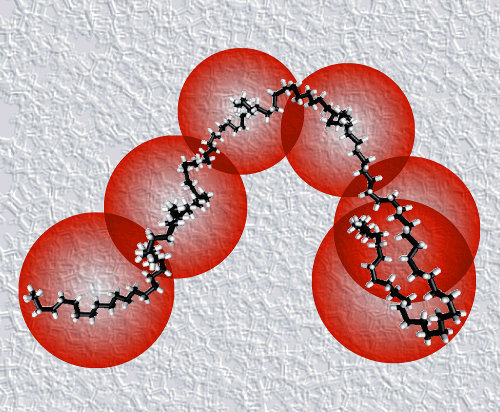coarse graining

Fully atomistic potentials have proven to be very useful
in the simulation of numerous systems.
They are, however,
less suited for simulating larger systems on longer time scales
due to their computational requirements.
It then proves advantageous
to describe the system on a "higher"
coarse grained level,
where particles represent entire groups of atoms.
We have developed two systematic methods
for deriving the effective interactions between particles
representing large fragments of a polymer.
The first approach is based on representing the
structural properties on the coarse level as good as possible,
while the second approach aims at
reproducing the free energy of the underlying atomic system,
i.e. the system that one really wants to describe, as good as possible.
entanglements
An important feature of a melt of long polymers is that
the bonds of the chains can not cross each other.
This seemingly simple fact has a large impact
on the long time dynamics and rheology of the material.
In coarse grained polymer models,
where a polymer is reduced to a chain of soft particles,
this effect is lost.
Hence, the coarse-grained melt no longer behaves like a real melt.
We have developed the
TWENTANGLEMENT algorithm
to re-introduce the
uncrossability of chains,
by explicitly keeping track of when and where chains entangle.
A repulsive force is introduced for every crossed pair,
to gradually drive the pair back to the uncrossed state.
The effect of these entanglements
on the dynamics and rheology of the system has been studied.
melt dynamics
Simulations of polyethyline (PE) melts using TWENTANGLEMENT,
based on coarse-grained potentials
derived from atomistic simulations of short polymers,
have enabled us to calculate the rheological properties of PE melts
for polymers up to 1000 carbons.
The additional order in length scale relative to atomistic simulations
achieves the cross-over
from the non-entangled Rouse regime
to the strongly entangled reptation regime.
We find a diffusion coefficient scaling with chain-length to the power -2
and a viscosity scaling with the power -3.5.
These results are in spectacular agreement with experiments.

 Fully atomistic potentials have proven to be very useful
in the simulation of numerous systems.
They are, however,
less suited for simulating larger systems on longer time scales
due to their computational requirements.
It then proves advantageous
to describe the system on a "higher" coarse grained level,
where particles represent entire groups of atoms.
We have developed two systematic methods
for deriving the effective interactions between particles
representing large fragments of a polymer.
The first approach is based on representing the
structural properties on the coarse level as good as possible,
while the second approach aims at
reproducing the free energy of the underlying atomic system,
i.e. the system that one really wants to describe, as good as possible.
Fully atomistic potentials have proven to be very useful
in the simulation of numerous systems.
They are, however,
less suited for simulating larger systems on longer time scales
due to their computational requirements.
It then proves advantageous
to describe the system on a "higher" coarse grained level,
where particles represent entire groups of atoms.
We have developed two systematic methods
for deriving the effective interactions between particles
representing large fragments of a polymer.
The first approach is based on representing the
structural properties on the coarse level as good as possible,
while the second approach aims at
reproducing the free energy of the underlying atomic system,
i.e. the system that one really wants to describe, as good as possible.